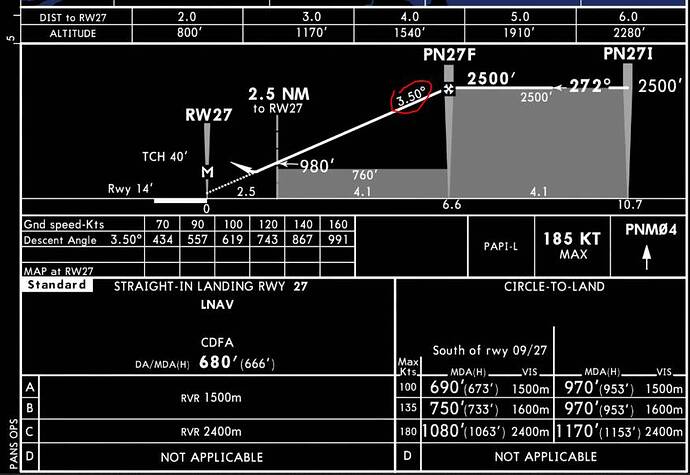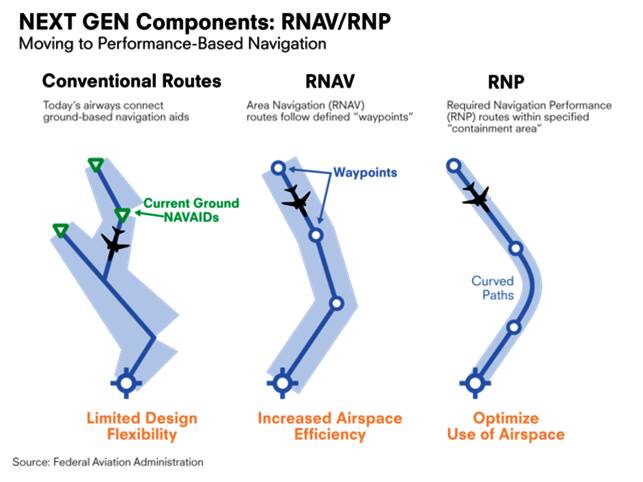I have only ever tried ILS approaches which are easy. Im just about to attempt an RNAV approach on Runway 27 @ Dundee Airport (EGPN) and noticed it has an LNAV approach which doesn’t include vertical guidance. My question is in real life how does the pilot manage an approach with no vertical guidance ?
Do I use VS with a 3 degree glide slope ? or just manually position it 3 degrees and hope ? presumably I don’t have to touch the throttle as the auto throttle will be in use ?
Any help welcome
Sorry i cant answer your question never landed there but in real life can a Airbus A320 land there being how short the runway is?
Im about to find out. EFB landing calculator reckons I can just about make it with full manual braking
1 Like
From the chart it seems it’s 3,5 degrees:
Moved to #self-service:aircraft-systems
EGPN runway 27 has an RNP approach, so there is vertical guidance (it’s just that the FBW A320 does not support those yet)
So yeah, for now you’d use FPA/TRK mode and dial in a -3.50 angle (as shown on the approach chart), and then activate the FPA descend about 0.3 nm before you hit PN27F. Should get you down nicely to the runway…
2 Likes
Is there a tutorial for this? Where can I activate the mode and select the g/s angle?
It’s not a tutorial, but I livestreamed all my flights to my YouTube channel.
Here’s my most recent RNAV approach with FPA/TRK. I’ve set it to start just before I activate the FPA/TRK, and managing my rate of descent through the angle.
2 Likes
First look up the glidepath angle for the approach, what we do in real life is selecting the selected altitude UP at least 300 ft when in ALT green mode. The aircraft will remain in ALT green, but the altitude is now “unlocked”, in other words you can use VS or FPA mode to descent. When 300 ft below missed approach altitude you can select the missed approach altitude. Some operators might select the altitude DOWN to MDA, but with modern CDFA approaches that’s useless. We usually fly these non-precision approaches fully configured, so before FAF, gear and flaps down and at approach speed. Upon reaching the FAF (ideally 0.3 nm before) select VS mode with the required vertical speed or even better, FPA mode with the required glide path. The real Airbus must have “advisory-VNAV”, which is vertical guidance for reference only. Either way, having advisory-VNAV or not, when flying a RNP approach down to LNAV or LP minima is considered a non-precision approach and you need to crosscheck the altitude versus DME distance (corrected for non standard temperature) on the way down and adjust the descent path as required.
If you look all the way on top of the screenshot posted by @TidalPopcorn618, you can see the DME versus altitude you should cross check.
Something interesting to know maybe, Jeppesen calls minima on non-precision approaches DA (Decision Altitude) or as in this case MDA / DA. Minima for non-precision approaches are always MDA (Minimum Descent Altitude). With a Decision Altitude you make the decision at that DA, if you decide to go-around you will descent slightly through it before positive climb is established. That is fine because there is a height loss correct per aircraft category built-in. You are NOT allowed to descent below MDA though and therefore the decision should be made before passing MDA. The operator determines a height-loss correction to make a “pilot derived DA” from the MDA. Something like +50 ft should do the trick. So in this case “pilot derived DA” = 730 ft.
3 Likes
Awesome. Thanks everyone.
I get very confused by all the terminology. I watched a video by a YouTuber called Kipontheground which says that “LNAV” approaches do not have vertical guidance whereas “LNAV/VNAV” approaches do.
On the chart for Runway 27 it says that it is an LNAV approach. But it does also mention RNP. Does RNP override LNAV ? I wish there was just a basic guide for all the different terminology when it comes to what Microsoft flight simulator calls ‘RNAV’ approaches.
RNAV means area navigation, instead of flying from beacon to beacon an RNAV equipped aircraft is able to fly to any random point not based on a conventional navaid. Some airspace you need to be RNAV-5 equipped for example (also called Basic RNAV - BRNAV), which means that the aircraft must be able to fly within 5 nm of its intended track for 95% of the flight time. For terminal operations, SIDs and STARs at large airports you often need to be able to fly RNAV-1 (also called Precision RNAV - PRNAV).
RNP stands for Required Navigation Performance, the difference between RNAV and RNP is that RNP requires an onboard monitoring and alerting system to warn the crew that the Actual Navigation Performance (ANP) exceeds the RNP, thats the main difference. There are some more feature such as turns with a fixed radius instead of fly-by or fly-over a waypoint, but in the basis the monitoring and alerting requirement is the main difference.
This is the drawing you will often come across explaining the difference between conventional navigation, RNAV and RNP:
In Europe all approaches are now called RNP approaches and not RNAV. So RNAV or RNP is a way of navigating, not an approach by it self.
The approach is called an RNP approach. Those can be split in three categories:
- Non-precision approach (NPA)
- Approach with Vertical Guidance (APV)
- Precision Approach (PA )
LNAV and LP are NPAs, LNAV / VNAV and LPV are APV approaches, LPV CAT I is a PA. Then there is RNP-AR which is an APV approach, AR stands for Authorization Required, so the operator needs special approval and crew probably needs special training to fly those.
- NPA: LNAV and LP
- APV: LNAV / VNAV, LPV and RNP-AR
- PA: LPV CAT I
LNAV = Lateral Navigation
VNAV = Vertical Navigation
LP = Localizer Performance (more accurate)
LPV = Localizer Performance with Vertical guidance
LNAV and LP don’t have vertical guidance but they can have “advisory-VNAV”, so the FMS provides vertical guidance but it’s only for reference, you need to cross check the DME versus altitude.
2 Likes


